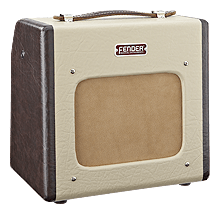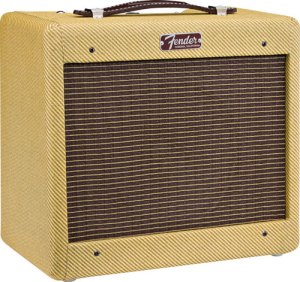 Some people may scoff at the diminutive Fender Champ 600. After all, it’s only 5 Watts and has a tiny 6″ speaker. But those naysayers may be missing the point about the Champ or any super-low wattage speaker for that matter. It’s not meant to be a performance amp; though you can certainly hook it up to an extension cabinet, and it’ll do just fine in a small venue – hey! I do that A LOT. But the secret behind the beauty of this little $149 wonder isn’t on the stage, it’s in the studio.
Some people may scoff at the diminutive Fender Champ 600. After all, it’s only 5 Watts and has a tiny 6″ speaker. But those naysayers may be missing the point about the Champ or any super-low wattage speaker for that matter. It’s not meant to be a performance amp; though you can certainly hook it up to an extension cabinet, and it’ll do just fine in a small venue – hey! I do that A LOT. But the secret behind the beauty of this little $149 wonder isn’t on the stage, it’s in the studio.
I’ve heard feedback from various people that they get frustrated with this amp because it’s missing certain features. Let’s face it folks, with a single volume knob, no tone control, and not much gain on tap, it would be easy to dismiss this amp as nothing more than a toy. But it’s no mistake that its venerable sibling, the Champ, has been a mainstay in professional studios for decades. It’s all in how you make use of what it has to offer.
First off, let’s establish what I think is the most important thing when recording this amp: The Champ is really good at creating your base tone, and that’s all that it should be used for. It’s up to you to shape it. Keep that in mind, and you’ll get more than a lot of mileage out of it. So let’s look at some key factors when recording with the Champ:
- The Champ is naturally bright because of its small speaker. So microphone placement is absolutely critical. If you want to get a bright, twangy sound with lots of treble content, place your mic head on in the center of the cone, or just off center to avoid getting those treble “pops.” If you want less treble response, move the mic off-center, nearer to the edge of the speaker cone. I’ve found that the richest sound comes from angling the mic at about the same angle as the speaker cone, placed right at the outer ring about an inch off the grille cloth. The EQ response is a lot flatter there, and makes it easy to dial in your EQ in your DAW.
- Even cranked in the high input, and even with humbuckers, the most breakup you’ll get is about “dirty blues” overdrive. But that’s why we have overdrive and distortion pedals, right? I’ve found that Tube Screamer and TS-type overdrive pedals work great with the Champ, though my Holy Fire distortion can make the Champ serve up some whoop-ass if dialed in just right.
- Looking for Fender cleans? The Champ does raw Fender cleans – and quite well. Again, it’s all about mic placement when recording cleans with the Champ. My favorite is angled as I described above.
- Do yourself a favor and replace the stock tubes with NOS tubes. I’ve never been a big fan of Groove Tubes (though I know some people like them). But with a great NOS pre-amp tube (I’ve got a ’59 GE long plate), and a solid NOS 6V6 (mine is a ’53 GE 6V6), you’ll immediately tame the harshness of the amp. In fact, I’ve never seen a need to replace the power transformer or the speaker because of this $50 investment.
So with those points in mind, go and record. What you’ll get after you’ve played around a bit is a great, raw guitar tone. But your work isn’t done yet – or it could be if you’re satisfied with the raw tone. Personally, I like to add filters and effects in production to make the recording sound like it’s coming from a much bigger amp. Yes, boys and girls, you can make it sound MUCH bigger!
A Word on Amp Modeling
One thing that I have also done with the Champ is to record a purely clean rhythm tone, then run it through IK Multimedia’s Amplitube plug-in to essentially “re-amp” my guitar. You can get some amazing guitar tones with the Champ when it’s re-amped through this software.
My Champ 600 Recording Process
A couple of people have asked me how to record the amp, so I thought I’d share the process I employ:
- First, it starts with the guitar. Am I looking for a single-coil or humbucker tone. The cool thing about the Champ 600 is that what you hear when you play through it is your raw guitar tone. There’s no EQ so you have to establish that on your guitar. Simple enough.
- Then I’ll determine whether or not I want to track with effects. Usually, I’ll only track with overdrive or distortion. I leave all the modulation effects to production.
- Next, I place my mic head, dead-center on the speaker, then record a chord progression and perhaps some quick lead licks.
- Then I’ll move the mic off-center and repeat the same thing I played with the mic centered.
- Finally, I’ll angle the mic as described above and repeat the same progression. More likely than not, I’ll use this position because I like it the best, but different guitars actually sound better with the mic positioned dead-center.
- Once I decide what mic position I’ll use, then I’ll record the track.
- Once I’m finished, it’s time to apply EQ, filters and modulation effects. I like to use a hi-pass filter on most recordings with Champ to “tame” its natural edginess.
Here are some clips that I put together based upon the process above (I skipped recording head-on, off center):
Clean (Squier Classic Vibe Tele 50’s)
1. Mic head-on, dead-center
2. Mic angled along speaker cone, 1″ off the grille cloth.
Recording #2 with Graphic EQ, Chorus, Parametric EQ, Delay, Reverb, and Hi-pass filter applied
Overdriven with Tube Screamer for Extra Drive (Gibson Nighthawk 2009)
1. Mic head-on, dead-center
2. Mic angled along speaker cone, 1″ off the grille cloth.
Recording #2 with Graphic EQ, Flange, Delay, Reverb, and Hi-pass filter applied
It’s amazing what EQ, filters and effects can do to the recording! And it really didn’t take that much work to dial in the final version of what I wanted to ultimately print!
Finally, here’s a song I wrote and record awhile back (sorry for the over-abundance of bass). If I remember correctly, I used four guitars in six parts in that song (Epiphone Explorer, Gibson ES-335, MIM Strat, PRS SE Soapbar II), all recorded with the Champ – and with the stock speaker no less!
Rock on!!!







